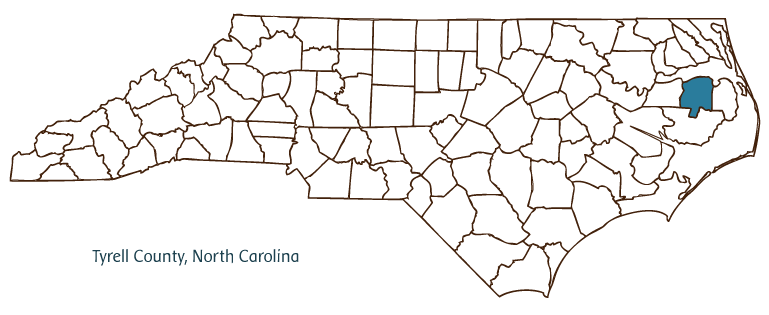TYRRELL COUNTY GOVERNMENT:
tyrrellcounty.org
COUNTY SEAT: Columbia
FORMED: 1729
FORMED FROM: Chowan, Bertie, Currituck, Pasquotank
LAND AREA: 389.04 square miles
2020 POPULATION ESTIMATE: 3,245
White: 56.7%
Black/African American: 38.1%
American Indian: 0.9%
Asian: 2.3%
Pacific Islander: <0.1%
Two or more races: 2.3%
Hispanic/Latino: 9.4% (of any race)
From State & County QuickFacts, US Census Bureau, 2020.
CONGRESSIONAL DISTRICT: 3RD
BIOGRAPHIES FOR ![]()
Tyrrell County
 WILDLIFE PROFILES FOR
WILDLIFE PROFILES FOR
Coastal Plain
GEOGRAPHIC INFORMATION
REGION: Coastal Plain
RIVER BASIN: Pasquotank, Map
NEIGHBORING COUNTIES: Dare, Hyde, Washington

Tyrrell County is located on the southern shore of Albemarle Sound, in the Coastal Plain of northeastern North Carolina. Named for Sir John Tyrrell, one of the Lords Proprietors, the county was formed in 1729 from Chowan, Bertie, Currituck and Pasquotank Counties. It is bordered to the east by the intracoastal waters of the Alligator River. Its county seat, Columbia, was incorporated in 1793 as Elizabeth Town and renamed in 1801. Other communities in the county include Gum Neck, Kilkenny, Fort Landing, Frying Pan Landing, Newfoundland, and Woodley.
Tyrrell County is dominated by its coastlands and its swamps, and the terrain has limited development and population growth since the county was founded. In 2004 Tyrrell County was the state's least populous, with an estimated 4,100 residents. But it is a popular location for fishing and other water sports, hunting, and bird watching. The 110,000-acre Pocosin Lakes National Wildlife Refuge was established in 1990 and is headquartered in Columbia. The refuge and surrounding county lands are home to one of the last large habitats for black bears on the eastern seaboard. Pocosin Arts in Columbia is among the premier arts organizations in the state.
Annotated history of Tyrrell County's formation:
For an annotated history of the county's formation, with the laws affecting the county, boundary lines and changes, and other origin information, visit these references in The Formation of the North Carolina Counties (Corbitt, 2000), available online at North Carolina Digital Collections (note, there may be additional items of interest for the county not listed here):
County formation history: https://digital.ncdcr.gov/Documents/Detail/the-formation-of-the-north-ca...
Index entry for the county: https://digital.ncdcr.gov/Documents/Detail/the-formation-of-the-north-ca...
Additional resources:
Corbitt, David Leroy. 2000. The formation of the North Carolina counties, 1663-1943. https://digital.ncdcr.gov/Documents/Detail/the-formation-of-the-north-carolina-counties-1663-1943/3692099?item=4553233 (accessed June 20, 2017).
Tyrrell County Government: http://tyrrellcounty.org/en/
Tyrrell County resources, NC Digital Heritage Center: https://www.digitalnc.org/counties/tyrrell-county/
North Carolina Digital Collections (explore by place, time period, format): https://digital.ncdcr.gov
Image credits:
Rudersdorf, Amy. 2010. "NC County Maps." Government & Heritage Library, State Library of North Carolina.
1 January 2006
